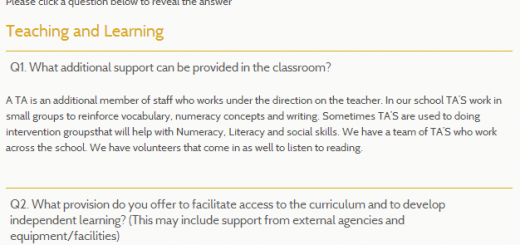Featuring your school curriculum for Ofsted

What, if anything, should schools do to ensure that the school curriculum on their website is ready for Ofsted?
There are already a few myths being bandied about around the new Ofsted Inspection Framework for schools in England. There is much scaremongering around, particularly concerning how schools should publish their curriculum on their school website for Ofsted. One of these myths, around ‘Intent’, has been busted on this Ofsted blog. Included in the blog is this definition around curriculum:
Intent is about what leaders intend pupils to learn. It’s as simple as that. Intent is everything up to the point at which teaching happens. Good intent, according to our handbook, has the following features:
- a curriculum that is ambitious for all pupils
- a curriculum that is coherently planned and sequenced
- a curriculum that is successfully adapted, designed and developed for pupils with special educational needs and/or disabilities
- a curriculum that is broad and balanced for all pupils
Also importantly the Ofsted blog states:
So, intent is nothing new. There’s no need to write new statements, adapt websites or restructure staffing to cover intent. Intent is not the next big thing.
There should be nothing new in the way a school approaches the writing of their curriculum for Ofsted. It is not about putting it all over your website under loads of special “Ofsted-approved” headings or pages either. Nothing exists which dictates this anywhere in the documentation.
However, we do know that schools like to feature their curriculum on their website. Not just for Ofsted (although making the school curriculum easy to find for Ofsted may be a bonus even if they don’t require a particular format!) but for parents and students of the school. Seeing what their children are learning, and will be learning, is a really important part of progression and the home-school communication links. If they can see how their current learning fits in with later curriculum, it can really help to frame everything and provide context. Also for students who are looking to make choices for GCSE or A levels it may provide an understanding of what will be included and, therefore, help them to make informed choices.
So how best do you feature your school curriculum on your website for the benefit of your visitors?
Subject lists
If you don’t want to feature every single mid term plan or lesson resources then the Hadleigh High School approach might be the best route for you. They have a list of subjects and then a clear split for Key Stage 3 and Key Stage 4 showing topics to be covered. A very simple, yet very effective, layout. They also include relevant exam board information in a very clear way.

Pelham Primary School have included subject-by-subject explanations of not just the coverage but also the pedagogical decisions made to support the children in school with their learning – including for those needing interventions. They have also listed parental expectations where relevant.

Year group curriculum overviews
Canada Hill Primary School have chosen to add, for each year group, curriulum overviews plus specific spelling and vocab/grammar information. These will be really easy for a parent to find and see exactly what their child will be learning. This can lead to, especially at primary school, more engagement from parents in homework and supporting learning in “real” settings such as paying for the shopping when they are studying money.

Curriculum rationale
Oxford Road Community School have included a page with their curriculum rationale, then links through to the full documents detailing their pedagogy and the coverage for each subject.

As we saw in the Ofsted statements and blog at the beginning, there is no right or wrong way to write or display your curriculum. From a school website point of view all we can say is that however you want to include your curriculum, and what specifically you want to share – be that documents or links or embedded text and image, or even a video of you explaining it – we can accommodate that for you on your school website. We have lots of examples for you to see on the portfolio pages of our website so do have a look through for inspiration or give us a call if you don’t see what which fits your own imagination.











